HTML
--> --> -->Understanding diffractive deep inelastic scattering is a beneficial theoretical feature because 10 to 15 percent of all events observed at HERA are diffractive [5-7]. A large amount of the experimental data can be explained by perturbative QCD, but extrapolation to diffractive reactions must be performed carefully because most of them are sensitive to details of non-perturbative dynamics. Investigations on the diffraction process were reported in the pioneering work of Glauber [8] and that of Good and Walker based on a quantum mechanical effect [9].
Indeed, at small-x, a diffractive process in DIS in the electron-proton collision occurs in the form of
From the perspective of the color dipole approach, we can express the following: when
$ \begin{aligned}[b] \vert \Psi_{T}(z,r) \vert ^{2} =& _{T}\langle q\overline{q}\vert q\overline{q}\rangle _{T} \\ = &\dfrac{N_{c}\alpha_{em}}{2\pi^{2}}\sum\limits_{q} e_{q}^{2} [(z^{2}+(1-z)^{2})\varepsilon^{2}K_{1}^{2}(\varepsilon r) \\ &+m_{q}^{2}K_{0}^{2}(\varepsilon r)], \end{aligned}$  | (1) |
$ \begin{aligned}[b] \vert \Psi_{L}(z,r) \vert ^{2} =& _{L}\langle q\overline{q}\vert q\overline{q}\rangle _{L} \\ =& \frac{N_{c}\alpha_{em}}{2\pi^{2}}\sum\limits_{q} e_{q}^{2} 4 Q^{2}z^{2}(1-z)^{2} K_{0}^{2}(\varepsilon r), \end{aligned} $  | (2) |
In the above-mentioned equations, the fraction of the momentum carried by the quark, z, and the relative transverse separation of the
These equations include Gribov inelastic shadowing corrections to all multiple interactions, which is hardly possible within hadronic presentation [11]. For a dipole-proton interaction, we use the dedicated cross section formulated by Bartels, Golec-Bierant, and Kowalski as a suitable definition that involves the gluon distribution function [12]
$ \sigma_{q\overline{q}P}(x,r^{2} ) = \sigma_{0} \left \{ 1-\exp\left(-\dfrac{ \pi^{2}r^{2}\alpha_{s}(\mu^{2})xg(x,\mu^{2})}{3\sigma_{0}}\right) \right \}, $  | (3) |
$ \int_{-\infty}^{0} {\rm d}t {\rm e}^{B_{D}t}\dfrac{{\rm d}\sigma^{D}_{T,L}}{{\rm d}t}\vert_{t = 0} = \dfrac{1}{B_{D}}\dfrac{{\rm d}\sigma^{D}_{T,L}}{{\rm d}t}\vert_{t = 0}, $  | (4) |
$ \dfrac{{\rm d}\sigma^{D}_{T,L}}{{\rm d}t}\vert_{t = 0} = \dfrac{1}{16\pi} \Big (\langle \sigma^{2}_{q\overline{q}P}(x,r^{2}) \rangle_{T,L} - \langle \sigma_{q\overline{q}P}(x,r^{2}) \rangle^{2}_{T,L} \Big ). $  | (5) |
$ \begin{aligned} \langle \sigma _{q\overline{q}P}(x,r^{2}) \rangle_{T,L} =& _{L,T}\langle q\overline{q} \vert \sigma_{q\overline{q}P} (x,r^{2}) \vert q\overline{q} \rangle_{T,L}, \\=& \sigma_{T,L}^{\gamma^{\star}P}(x,Q^{2}), \\ =& \int_{0}^{1}{\rm d}z\int {\rm d}^{2}r \vert \Psi_{T,L}(z,r)\vert ^{2} \sigma_{q\overline{q}P}(x,r^{2}). \\\end{aligned} $  | (6) |
$\begin{aligned}[b] \dfrac{{\rm d}\sigma^{D}_{T,L}}{{\rm d}t}\vert_{t = 0} =& \dfrac{1}{16\pi} \Big (\langle \sigma^{2}_{q\overline{q}P}(x,r^{2}) \rangle_{T,L}\Big ),\\ =& \dfrac{1}{16\pi}\int_{0}^{1}{\rm d}z\int {\rm d}^{2}r \vert \Psi_{T,L}(z,r)\vert ^{2} \sigma^{2}_{q\overline{q}P}(x,r^{2}). \end{aligned} $  | (7) |
$ R_{0}^{2}(x) = \dfrac{1}{Q_{0}^{2}}\left(\dfrac{x}{x_{0}}\right)^{\lambda} = \dfrac{1}{Q_{s}^{2}}. $  | (8) |
According to Eq. (3), the selection of the gluon distribution is important. For small-r,
$ xg(x,\mu^{2}) = \dfrac{3\sigma_{0}}{4\pi^{2}\alpha_{s}R_{0}^{2}(x)}, $  | (9) |
$ \sigma_{q\overline{q}P}(x,r^{2} ) = \sigma_{0}\dfrac{r^{2}}{R_{0}^{2}(x)}. $  | (10) |
$ {\sigma _{q\bar qP}}(x,{r^2}) = \left\{ {\begin{array}{*{20}{c}} {{\sigma _0},}&{r > {R_0}}\\ {{\sigma _0}\dfrac{{{r^2}}}{{R_0^2}},}&{r < {R_0}} \end{array}} \right.$  | (11) |
Now, we are ready to determine the diffractive cross section. As the
There are two limit states that are interesting to investigate. One is the symmetric pairs with
$ \begin{aligned}[b] \dfrac{{\rm d}\sigma^{D}_{\rm tot}}{{\rm d}t}\vert_{t = 0} =& \dfrac{{\rm d}\sigma^{D}_{T}}{{\rm d}t}\vert_{t = 0}+\dfrac{{\rm d}\sigma^{D}_{L}}{{\rm d}t}\vert_{t = 0} , \\ =& \dfrac{3\alpha_{em}}{32\pi^{3}}\sigma^{2}_{0}\sum\limits_{q} e_{q}^{2}\Bigg \{ \int_{0}^{1}{\rm d}z(z^{2}+(1-z)^{2}) \\ &\times \int_{0}^{\textstyle\frac{1}{Q^{2}}}{\rm d}^{2}r\varepsilon^{2}\left(\dfrac{1}{\varepsilon^{2}r^{2}}\right)\left(\dfrac{r^{2}}{R_{0}^{2}(x)}\right)^{2} \\ &+\int_{0}^{1}{\rm d}z\int_{0}^{\textstyle\frac{1}{Q^{2}}}{\rm d}^{2}r m_{q}^{2}\left(\dfrac{r^{2}}{R_{0}^{2}(x)}\right)^{2} \\ &+\int_{0}^{1}{\rm d}z 4Q^{2}z^{2}(1-z)^{2} \\ &\times \int_{0}^{\textstyle\frac{1}{Q^{2}}}{\rm d}^{2}r\left(\dfrac{r^{2}}{R_{0}^{2}(x)}\right)^{2} \Bigg \}, \\ =& \dfrac{3\alpha_{em}}{32\pi^{2}}\sigma^{2}_{0}\dfrac{1}{3Q^{4}R_{0}^{4}(x)}\sum\limits_{q} e_{q}^{2}\Bigg \{\dfrac{17}{15}+\dfrac{m_{q}^{2}}{Q^{2}} \Bigg \}. \end{aligned}$  | (12) |
The idea of geometrical scaling has been based on expressing the total cross section as a function of the dimensionless variable
$ \sigma_{T,L}^{\gamma^{\star}P}(x,Q^{2}) = \sigma_{0}f(\tau). $  | (13) |
$ \dfrac{{\rm d}\sigma^{D}_{\rm tot}}{{\rm d}t}\vert_{t = 0} = \sigma^{2}_{0}g(\tau), $  | (14) |
$ \dfrac{{\rm d}\sigma^{D}_{\rm tot}}{{\rm d}t}\vert_{t = 0} = \dfrac{3\alpha_{em}}{32\pi^{2}}\sigma^{2}_{0}\dfrac{1}{3\tau^{2}}\sum\limits_{q} e_{q}^{2}\Bigg \{ \dfrac{17}{15}+\dfrac{m_{q}^{2}}{Q^{2}}\Bigg \}, $  | (15) |
$ g(\tau) = \dfrac{3\alpha_{em}}{32\pi^{2}}\dfrac{1}{\tau^{2}}\sum\limits_{q} e_{q}^{2}\Bigg \{ \dfrac{17}{45}+\dfrac{m_{q}^{2}}{3Q^{2}}\Bigg \}. $  | (16) |
$ \begin{aligned}[b] \dfrac{{\rm d}\sigma^{D}_{\rm tot}}{{\rm d}t}\vert_{t = 0} =& \dfrac{{\rm d}\sigma^{D}_{T}}{{\rm d}t}\vert_{t = 0}+\dfrac{{\rm d}\sigma^{D}_{L}}{{\rm d}t}\vert_{t = 0}, \\ =& \dfrac{3\alpha_{em}}{32\pi^{3}}\sigma^{2}_{0}\sum\limits_{q} e_{q}^{2}\Bigg \{ \int_{0}^{1}{\rm d}z(z^{2}+(1-z)^{2}) \\ & \times \int_{0}^{R_{0}^{2}}{\rm d}^{2}r\varepsilon^{2}\left(\dfrac{1}{\varepsilon^{2}r^{2}}\right)\left(\dfrac{r^{2}}{R_{0}^{2}(x)}\right)^{2} \\ &+\int_{0}^{1}{\rm d}z\int_{0}^{R_{0}^{2}}{\rm d}^{2}r m_{q}^{2}\left(\dfrac{r^{2}}{R_{0}^{2}(x)}\right)^{2} \\ &+\int_{0}^{1}{\rm d}z(z^{2}+(1-z)^{2}) \int_{R_{0}^{2}}^{\textstyle\frac{1}{Q^{2}}}{\rm d}^{2}r\varepsilon^{2}\left(\dfrac{1}{\varepsilon^{2}r^{2}}\right) \\ &+\int_{0}^{1}{\rm d}z\int_{R_{0}^{2}}^{\textstyle\frac{1}{Q^{2}}}{\rm d}^{2}r m_{q}^{2} \\ &+\int_{0}^{1}{\rm d}z 4Q^{2}z^{2}(1-z)^{2} \int_{0}^{R_{0}^{2}}{\rm d}^{2}r\left(\dfrac{r^{2}}{R_{0}^{2}(x)}\right)^{2} \\ &+\int_{0}^{1}{\rm d}z 4Q^{2}z^{2}(1-z)^{2} \int_{R_{0}^{2}}^{\textstyle\frac{1}{Q^{2}}}{\rm d}^{2}r \Bigg\}, \\ =& \dfrac{3\alpha_{em}}{32\pi^{2}}\sigma^{2}_{0}\sum\limits_{q} e_{q}^{2}\Bigg\{ \dfrac{1}{3}\Bigg(\dfrac{7}{5}-\log(R_{0}^{2}Q^{2})^{2} \\ &-\dfrac{4R_{0}^{2}Q^{2}}{15}\Bigg)+\dfrac{m_{q}^{2}}{Q^{2}}\left(1- \dfrac{2R_{0}^{2}Q^{2}}{3}\right) \Bigg \}. \end{aligned} $  | (17) |
$ g(\tau) = \dfrac{3\alpha_{em}}{32\pi^{2}}\sum\limits_{q} e_{q}^{2}\left \{ \dfrac{7}{15}-\dfrac{4\tau}{45}+\dfrac{m_{q}^{2}}{Q^{2}}\left(1- \dfrac{2\tau}{3}\right) \right \}. $  | (18) |
$ g(\tau) = \dfrac{3\alpha_{em}}{32\pi^{2}}\sum\limits_{q} e_{q}^{2}\Bigg \{ \dfrac{7}{15}+\dfrac{m_{q}^{2}}{Q^{2}} \Bigg \}. $  | (19) |
$ g(\tau) \cong O(\alpha_{em}). $  | (20) |
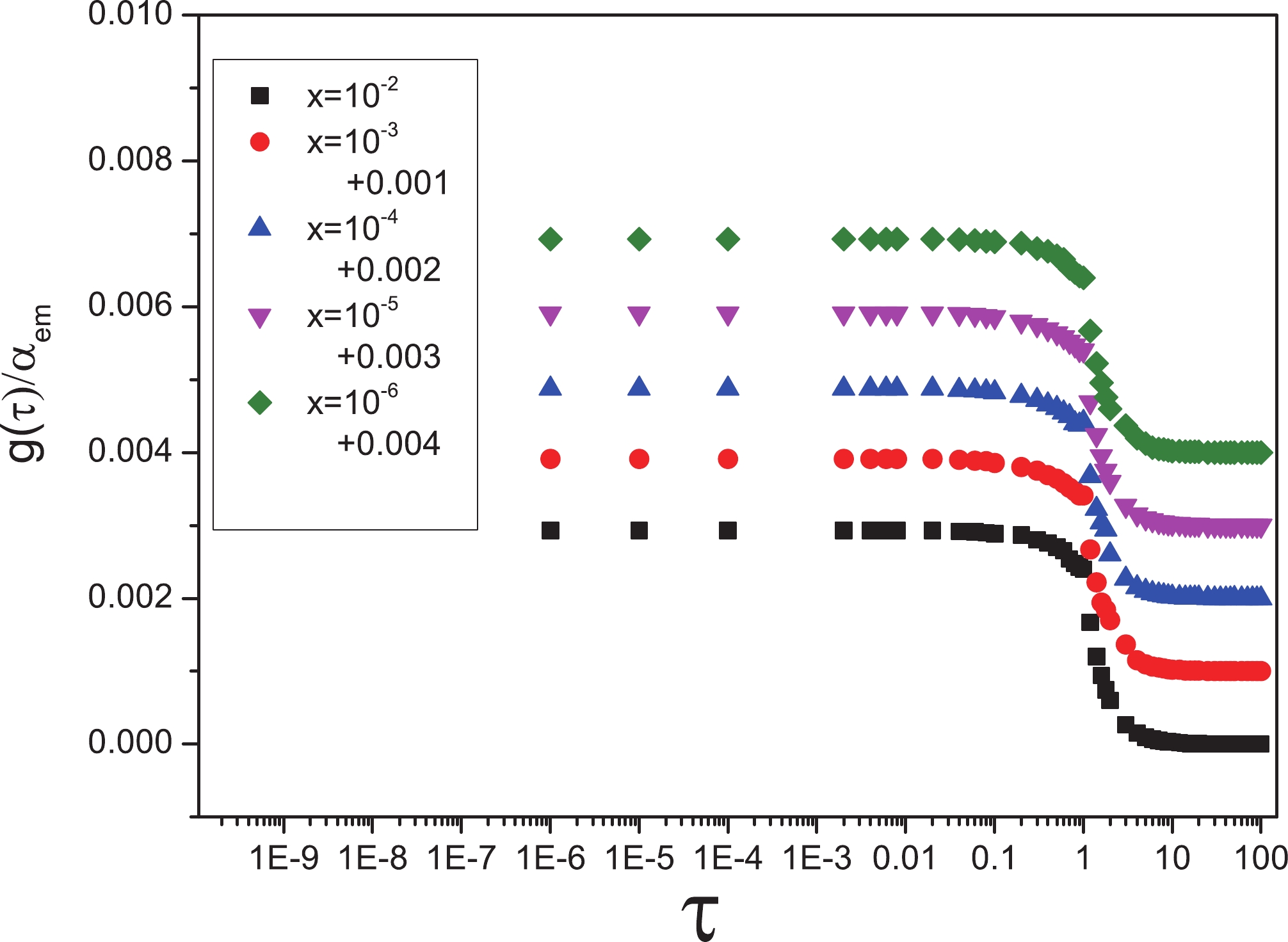 Figure1. (color online) Ratio
Figure1. (color online) Ratio $ \dfrac{g(\tau)}{\alpha_{em}} \sim 1 \longrightarrow \dfrac{g(\tau)}{\alpha_{em}} \sim \dfrac{1}{\tau^{2}}. $  | (21) |
$ \begin{aligned}[b] \dfrac{{\rm d}\sigma^{D}_{\rm tot}}{{\rm d}t}\vert_{t = 0} =& \dfrac{{\rm d}\sigma^{D}_{T}}{{\rm d}t}\vert_{t = 0}+\dfrac{{\rm d}\sigma^{D}_{L}}{{\rm d}t}\vert_{t = 0}, \\ =& \dfrac{3\alpha_{em}}{32\pi^{3}}\sigma^{2}_{0}\sum\limits_{q} e_{q}^{2}\Bigg \{ \int_{1/\mu^{2}}^{1/Q^{2}}{\rm d}^{2}r\varepsilon^{2}\left(\dfrac{1}{\varepsilon^{2}r^{2}}\right) \\ & \times \int_{0}^{\textstyle\frac{1}{r^{2}Q^{2}}}{\rm d}z(z^{2}+(1-z)^{2})\left(\dfrac{r^{2}}{R_{0}^{2}(x)}\right)^{2} \\ & + \int_{1/\mu^{2}}^{1/Q^{2}}{\rm d}^{2}r\int_{0}^{\textstyle\frac{1}{r^{2}Q^{2}}}{\rm d}z 4Q^{2}z^{2}(1-z)^{2}\left(\dfrac{r^{2}}{R_{0}^{2}(x)}\right)^{2} \Bigg \}, \\ & +\int_{1/\mu^{2}}^{1/Q^{2}}{\rm d}^{2}r m_{q}^{2}\int_{0}^{\textstyle\frac{1}{r^{2}Q^{2}}}{\rm d}z\left(\dfrac{r^{2}}{R_{0}^{2}(x)}\right)^{2} \\ =& \dfrac{3\alpha_{em}}{32\pi^{2}}\sigma^{2}_{0}\dfrac{\sum\limits_{q} e_{q}^{2}}{Q^{4}R_{0}^{4}(x)}\Bigg \{ \dfrac{29}{15}+\dfrac{1}{3}\log\left(\dfrac{\mu^{2}}{Q^{2}}\right) \\ &- \dfrac{4\mu^{2}}{3Q^{2}}+\dfrac{2\mu^{4}}{5Q^{4}}+\dfrac{m_{q}^{2}}{2Q^{2}}\left(1-\dfrac{Q^{4}}{\mu^{4}}\right) \Bigg \}. \end{aligned} $  | (22) |
$\begin{aligned}[b] g(\tau) =& \dfrac{3\alpha_{em}}{32\pi^{2}}\dfrac{1}{\tau^{2}}\sum\limits_{q} e_{q}^{2}\Bigg \{ \dfrac{29}{15}+\dfrac{1}{3}\log\left(\dfrac{\mu^{2}}{Q^{2}}\right) \\ &- \dfrac{4\mu^{2}}{3Q^{2}}+\dfrac{2\mu^{4}}{5Q^{4}}+\dfrac{m_{q}^{2}}{2Q^{2}}\left(1-\dfrac{Q^{4}}{\mu^{4}}\right) \Bigg \}. \end{aligned} $  | (23) |
$ \begin{aligned}[b] \dfrac{{\rm d}\sigma^{D}_{\rm tot}}{{\rm d}t}\vert_{t = 0} =& \dfrac{{\rm d}\sigma^{D}_{T}}{{\rm d}t}\vert_{t = 0}+\dfrac{{\rm d}\sigma^{D}_{L}}{{\rm d}t}\vert_{t = 0}, \\ =& \dfrac{3\alpha_{em}}{32\pi^{3}}\sigma^{2}_{0}\sum\limits_{q} e_{q}^{2}\Bigg \{ \int_{1/ \mu^{2}}^{R_{0}^{2}}{\rm d}^{2}r\varepsilon^{2}\left(\dfrac{1}{\varepsilon^{2}r^{2}}\right) \\ &\times \int_{0}^{\textstyle\frac{1}{r^{2}Q^{2}}}{\rm d}z(z^{2}+(1-z)^{2})\left(\dfrac{r^{2}}{R_{0}^{2}(x)}\right)^{2} \\ &+\int_{1/ \mu^{2}}^{R_{0}^{2}}{\rm d}^{2}r m_{q}^{2}\int_{0}^{\textstyle\frac{1}{r^{2}Q^{2}}}{\rm d}z\left(\dfrac{r^{2}}{R_{0}^{2}(x)}\right)^{2} \\ & + \int_{R_{0}^{2}}^{1/Q^{2}}{\rm d}^{2}r\varepsilon^{2}\left(\dfrac{1}{\varepsilon^{2}r^{2}}\right)\int_{0}^{\textstyle\frac{1}{r^{2}Q^{2}}}{\rm d}z(z^{2}+(1-z)^{2}) \\ &+\int_{R_{0}^{2}}^{1/Q^{2}}{\rm d}^{2}r m_{q}^{2}\int_{0}^{\textstyle\frac{1}{r^{2}Q^{2}}}{\rm d}z \\ &+ \int_{1/ \mu^{2}}^{R_{0}^{2}}{\rm d}^{2}r\int_{0}^{\textstyle\frac{1}{r^{2}Q^{2}}}{\rm d}z 4Q^{2}z^{2}(1-z)^{2}\left(\dfrac{r^{2}}{R_{0}^{2}(x)}\right)^{2} \\ & + \int_{R_{0}^{2}}^{1/Q^{2}}{\rm d}^{2}r\int_{0}^{\textstyle\frac{1}{r^{2}Q^{2}}}{\rm d}z 4Q^{2}z^{2}(1-z)^{2} \Bigg \}, \\ =& \dfrac{3\alpha_{em}}{32\pi^{2}}\sigma^{2}_{0}\sum\limits_{q} e_{q}^{2}\Bigg \{ \dfrac{-83}{90}+\dfrac{2}{R_{0}^{2}Q^{2}} \\ & +\dfrac{1}{R_{0}^{4}Q^{4}}\left(\dfrac{1}{6}+\dfrac{1}{3}\log(\mu^{2}R_{0}^{2})-\dfrac{4\mu^{2}}{3Q^{2}}+\dfrac{2\mu^{4}}{5Q^{4}}\right) \\ &+\dfrac{8}{9R_{0}^{6}Q^{6}}-\dfrac{1}{5R_{0}^{8}Q^{8}}+\dfrac{m_{q}^{2}}{2Q^{2}}1+\log\left(\dfrac{1}{Q^{2}R_{0}^{2}}\right) \Bigg \}, \end{aligned} $  | (24) |
$ \begin{aligned}[b] g(\tau) =& \dfrac{3\alpha_{em}}{32\pi^{2}} \sum\limits_{q} e_{q}^{2}\Bigg \{ \dfrac{-83}{90}+\dfrac{2}{\tau}+\dfrac{1}{\tau^{2}}\Bigg(\dfrac{1}{6}-\dfrac{4\mu^{2}}{3Q^{2}} \\ &+ \dfrac{2\mu^{4}}{5Q^{4}}\Bigg)+\dfrac{8}{9\tau^{3}}-\dfrac{1}{5\tau^{4}}+\dfrac{m_{q}^{2}}{2Q^{2}} \Bigg \}. \end{aligned} $  | (25) |
 Figure2. (color online) Ratio
Figure2. (color online) Ratio 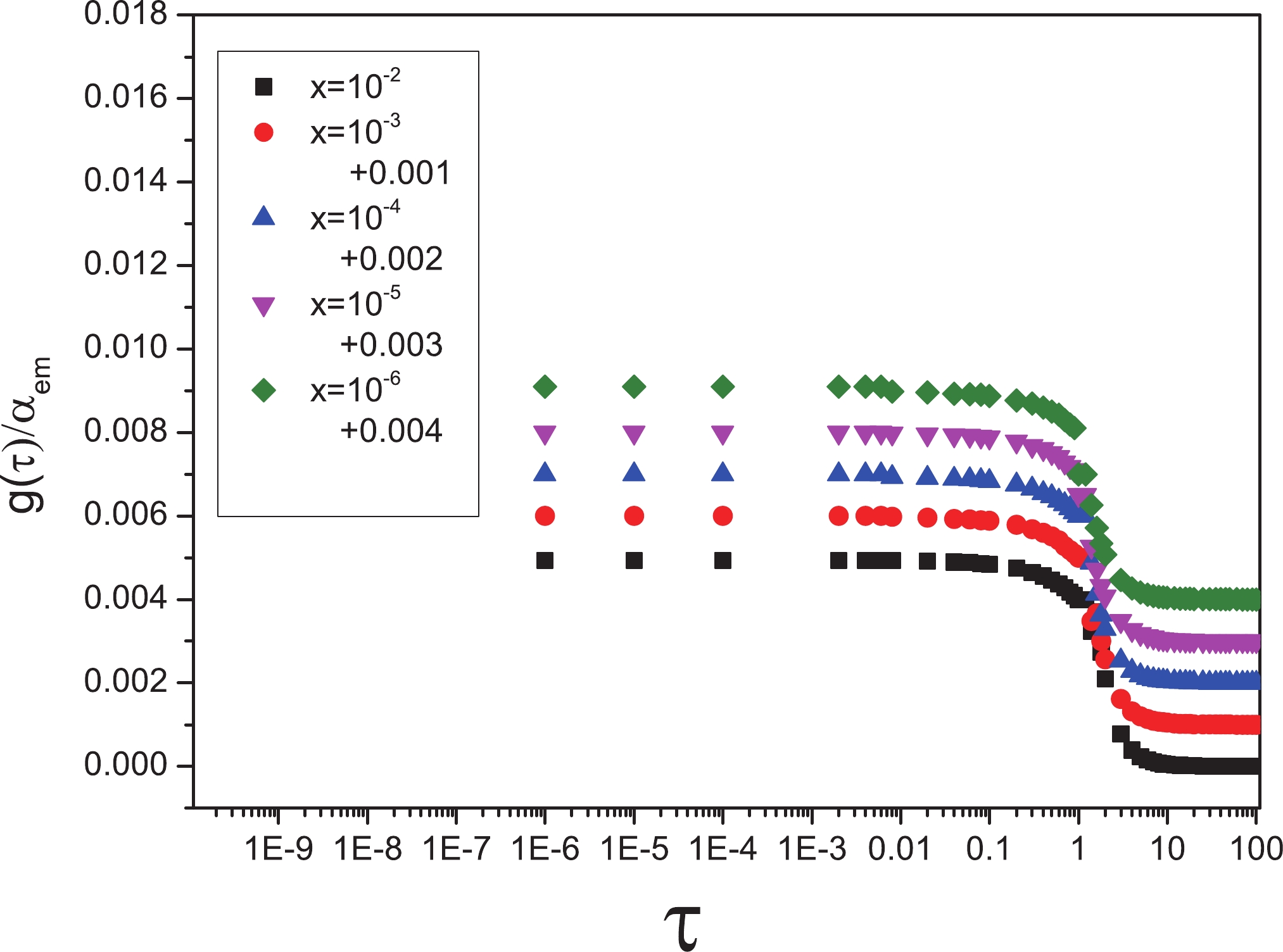 Figure3. (color online) Ratio of
Figure3. (color online) Ratio of Figure 4, considering the bottom quark with
 Figure4. (color online) Ratio of
Figure4. (color online) Ratio of We note that, as heavy production appears in the feature of a symmetric dipole, universal functions (16) and (18) are used in plotting the diagrams.
According to the H1 and ZEUS reports, the charm component of the structure function includes a significant fraction of the proton structure function [23, 24]. We calculate the contribution of this flavor in the diffractive cross section
$ \dfrac{\dfrac{{\rm d}\sigma_{c}^{D}}{{\rm d}t}\vert_{t = 0} }{\dfrac{{\rm d}\sigma ^{D}}{{\rm d}t}\vert_{t = 0}} = \dfrac{ g_{c}(\tau) }{g(\tau)} = \dfrac{\delta_{qc}\bigg ( g(\tau) \bigg )}{g(\tau)}, $  | (26) |
$ \begin{aligned}[b]&\dfrac{\dfrac{{\rm d}\sigma_{c}^{D}}{{\rm d}t}\vert_{t = 0} }{\dfrac{{\rm d}\sigma ^{D}}{{\rm d}t}\vert_{t = 0}} = \dfrac{ g_{c}(\tau) }{g(\tau)} = \\ & \dfrac{e_{c}^{2}\left(\dfrac{17}{45}+\dfrac{m_{c}^{2}}{3Q^{2}}\right)}{e_{c}^{2}\left(\dfrac{17}{45}+\dfrac{m_{c}^{2}}{3Q^{2}}\right)+(e_{u}^{2}+e_{d}^{2}+e_{s}^{2})\left(\dfrac{17}{45}+\dfrac{(0.140)^{2}}{3Q^{2}}\right)}. \end{aligned} $  | (27) |
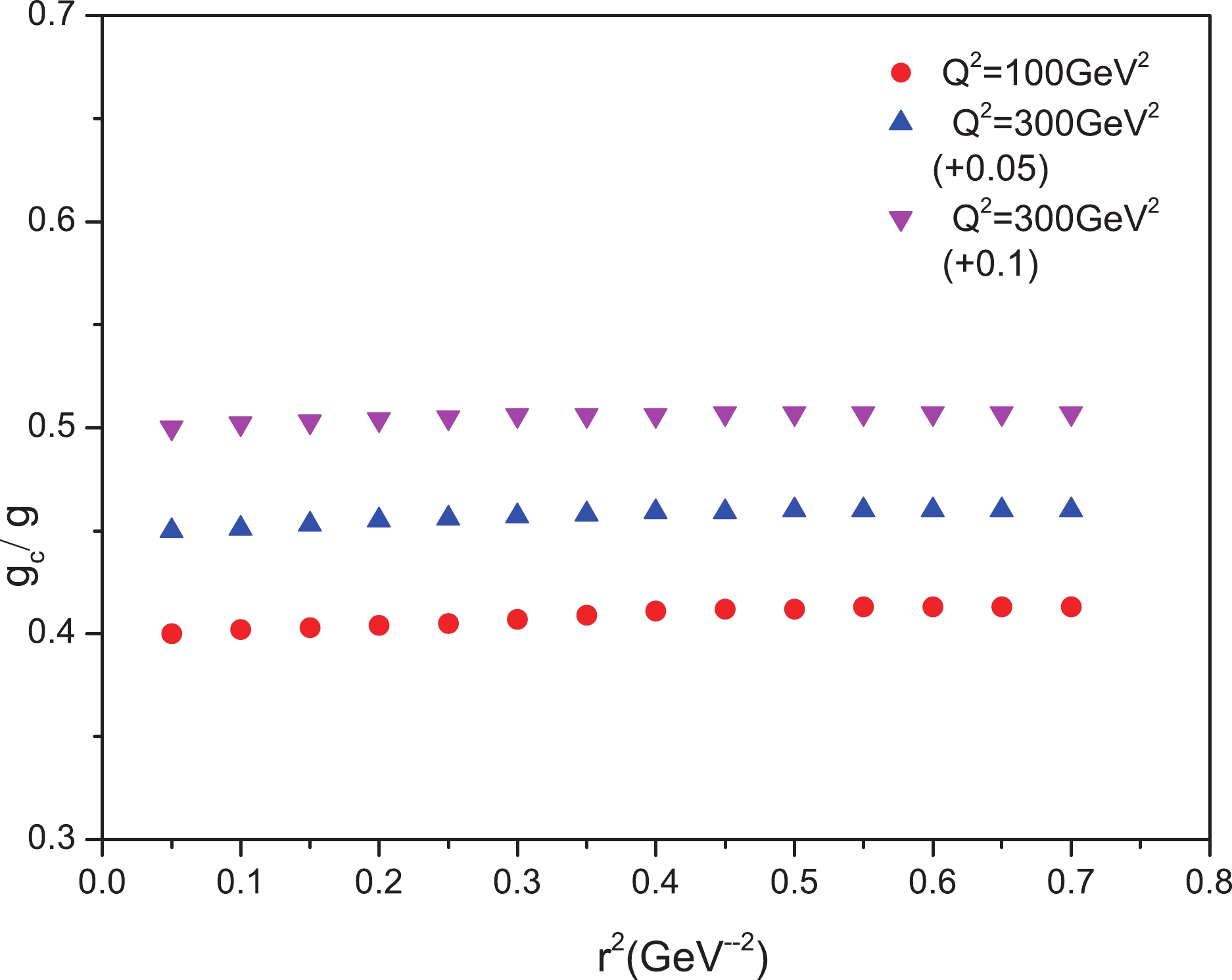 Figure5. (color online) Contribution of the charm quark in the diffractive cross section for
Figure5. (color online) Contribution of the charm quark in the diffractive cross section for We can calculate this fraction to estimate the bottom production
$ \dfrac{\dfrac{{\rm d}\sigma_{b}^{D}}{{\rm d}t}\vert_{t = 0} }{\dfrac{{\rm d}\sigma ^{D}}{{\rm d}t}\vert_{t = 0}} = \dfrac{ g_{b}(\tau) }{g(\tau)} = \dfrac{\delta_{qb}\bigg ( g(\tau) \bigg )}{g(\tau)}, $  | (28) |
$ \begin{aligned}[b]&\dfrac{\dfrac{{\rm d}\sigma_{b}^{D}}{{\rm d}t}\vert_{t = 0} }{\dfrac{{\rm d}\sigma ^{D}}{{\rm d}t}\vert_{t = 0}} = \dfrac{ g_{b}(\tau) }{g(\tau)} = \\ & \dfrac{e_{b}^{2}\left(\dfrac{17}{45}+\dfrac{m_{b}^{2}}{3Q^{2}}\right)}{e_{b}^{2}\left(\dfrac{17}{45}+\dfrac{m_{b}^{2}}{3Q^{2}}\right)+e_{c}^{2}\left(\dfrac{17}{45}+\dfrac{m_{c}^{2}}{3Q^{2}}\right)+\dfrac{2}{3}\left(\dfrac{17}{45}+\dfrac{(0.140)^{2}}{3Q^{2}}\right)}, \end{aligned} $  | (29) |
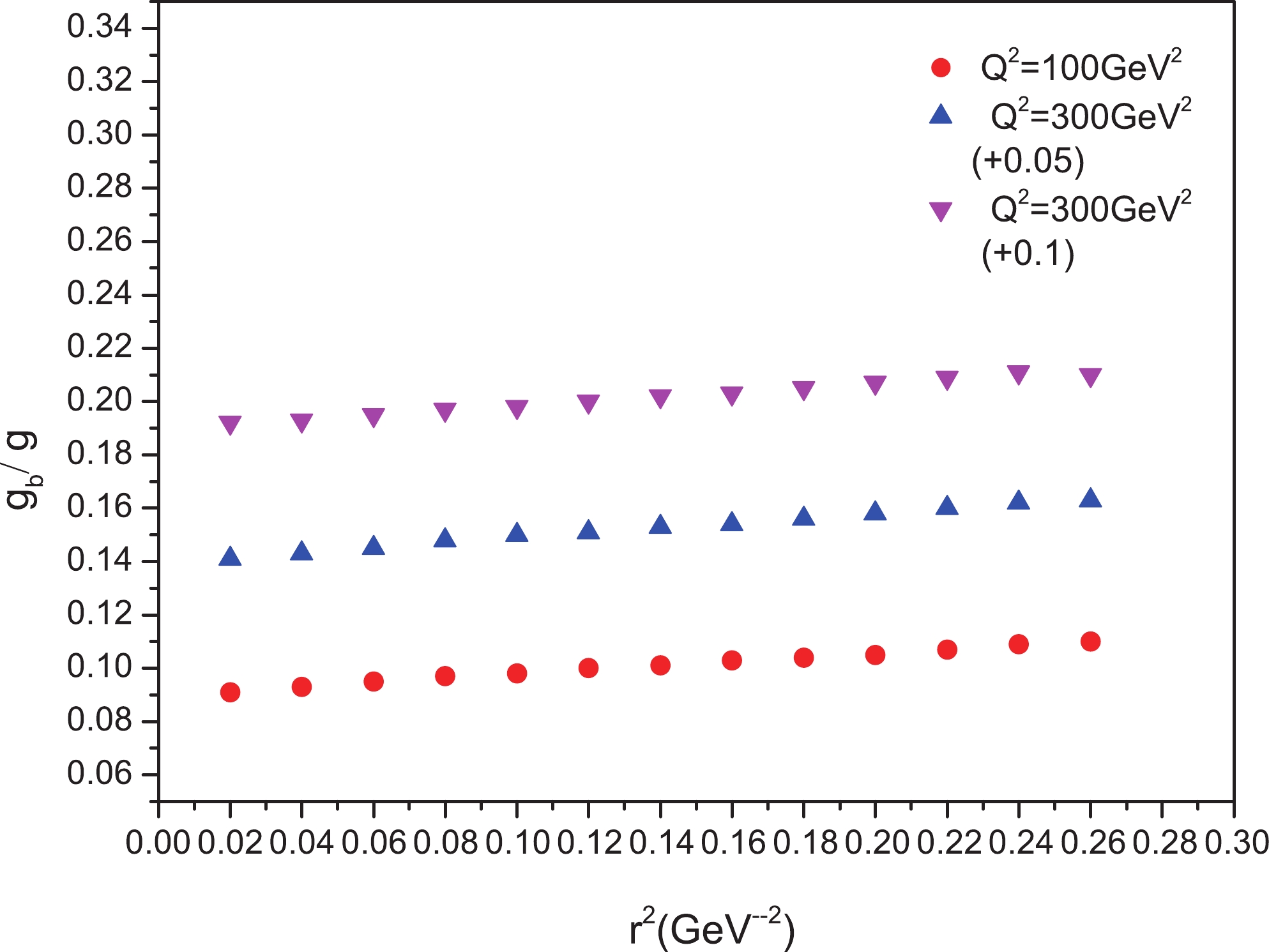 Figure6. (color online) Contribution of the bottom quark in the diffractive cross section for
Figure6. (color online) Contribution of the bottom quark in the diffractive cross section for To continue, we can take a step forward and obtain the ratio of the diffractive cross section to the total cross section [21]. For symmetric dipoles with
$ \begin{aligned}[b]R(\tau) =& \dfrac{\dfrac{{\rm d}\sigma^{D}_{\rm tot}}{{\rm d}t}\vert_{t = 0}}{\sigma^{\gamma^{\star}P}_{\rm tot} (x,Q^{2})} = \dfrac{\sigma_{0}^{2}g(\tau)}{\sigma_{0}f(\tau)} \\ =& \dfrac{\sigma_{0}}{16\pi \tau} \left ( \dfrac{\sum_{q} e_{q}^{2}\left(\dfrac{17}{45}+\dfrac{m_{q}^{2}}{3Q^{2}}\right)}{\sum_{q} e_{q}^{2}\left(\dfrac{11}{15}+\dfrac{m_{q}^{2}}{2Q^{2}}\right)} \right ),\end{aligned} $  | (30) |
$ \begin{aligned}[b]R(\tau) =& \dfrac{\dfrac{{\rm d}\sigma^{D}_{\rm tot}}{{\rm d}t}\vert_{t = 0}}{\sigma^{\gamma^{\star}P}_{\rm tot} (x,Q^{2})} = \dfrac{\sigma_{0}^{2}g(\tau)}{\sigma_{0}f(\tau)} \\ =& \dfrac{\sigma_{0}}{16\pi } \left ( \dfrac{\sum_{q} e_{q}^{2}\left(\dfrac{7}{15}-\dfrac{4\tau}{45}+\dfrac{m_{q}^{2}}{Q^{2}}\left(1-\dfrac{2\tau}{3}\right)\right)}{\sum_{q} e_{q}^{2}\left(\dfrac{4}{5}-\dfrac{4\tau}{60}+\dfrac{m_{q}^{2}}{Q^{2}}\left(1-\dfrac{\tau}{2}\right)\right)} \right ). \end{aligned} $  | (31) |
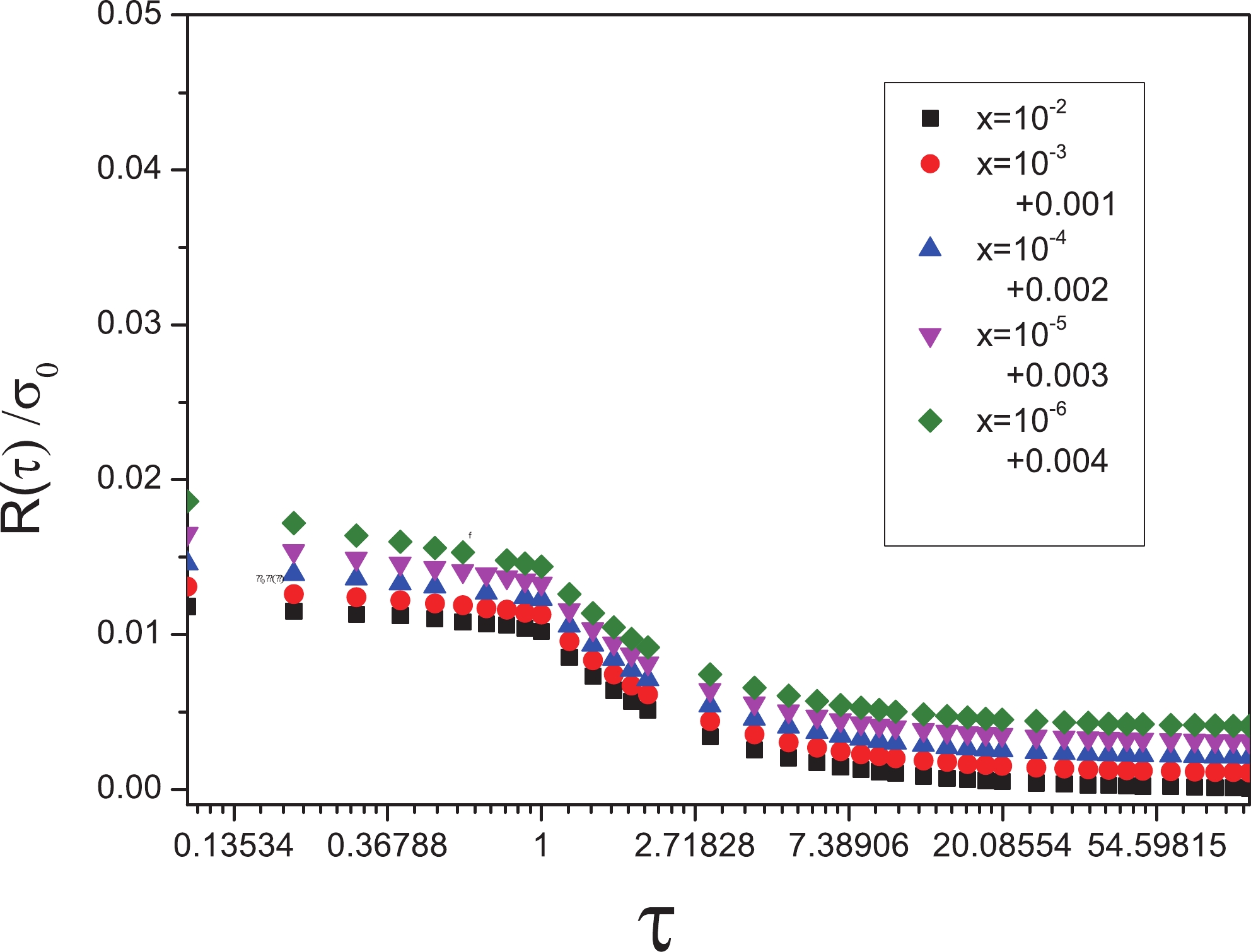 Figure7. (color online) Ratio
Figure7. (color online) Ratio Our other suggestion for showing the ratio of the diffractive cross section to the total cross section is independent of x and
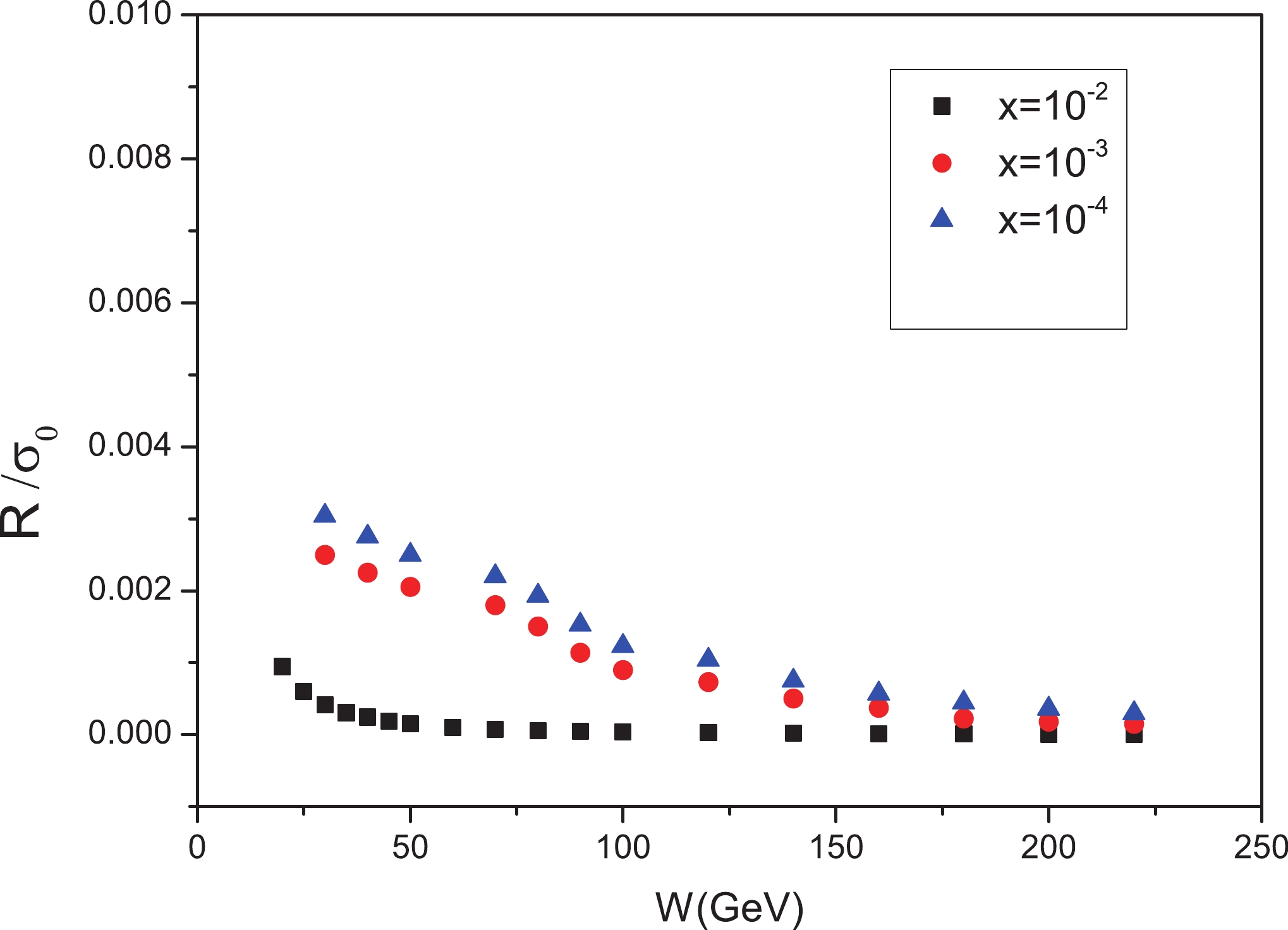 Figure8. (color online) Ratio
Figure8. (color online) Ratio We come to the conclusion that, in both the symmetric and asymmetric dipoles, the diffraction is sensitive to the saturation effect because the diffractive cross section is proportional to
The probability of the charm production in
The ratio of the diffractive cross section to the total cross section depicted in Fig. 7 is the other quantity that depends on the inherent characteristics of the dipoles and remains unchanged relative to the x variable. Fig. 8 offers further validation of this ratio invariance.
The significant conclusion of this work is that the diffractive event in the color dipole model probes QCD in a different way; for instance, the unitarity is an important component associated with the saturation effect that leads to a good description of the data.
In conclusion, the idea of geometrical scaling for the diffractive cross section is established. The universal functions obtained are not bounded functions and only depend on the inherent properties of dipoles.
